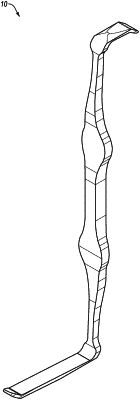| CPC A61B 17/02 (2013.01) [A61B 2017/00424 (2013.01)] | 31 Claims |

|
1. A surgical retractor, comprising an elongate body extending along a longitudinal axis between a proximal end having a proximal blade portion extending transversely to the longitudinal axis and an opposite distal end having a distal blade portion extending transversely to the longitudinal axis, wherein:
the elongate body includes an intermediate connecting portion positioned between a first portion and a second portion, the first portion being positioned between the proximal and distal ends and having an enlarged lateral width, extending in a first direction relative to the longitudinal axis, relative to the intermediate connecting portion, and the second portion being positioned between the intermediate connecting portion and the distal end and having an enlarged lateral width, extending in the first direction, relative to the intermediate connecting portion;
the first portion includes a first concave surface positioned on a first side of the longitudinal axis, the first concave surface curving toward the longitudinal axis in a second direction extending transversely to the first direction;
the second portion includes a second concave surface positioned on an opposite, second side of the longitudinal axis relative to the first concave surface, the second concave surface curving toward the longitudinal axis in a third direction extending transversely to the first direction; and
the intermediate connecting portion spaces the first concave surface from the second concave surface in a proximal-distal direction along the longitudinal axis in an arrangement where a proximal most portion of the second concave surface terminates distally of a distal most portion of the first concave surface.
|